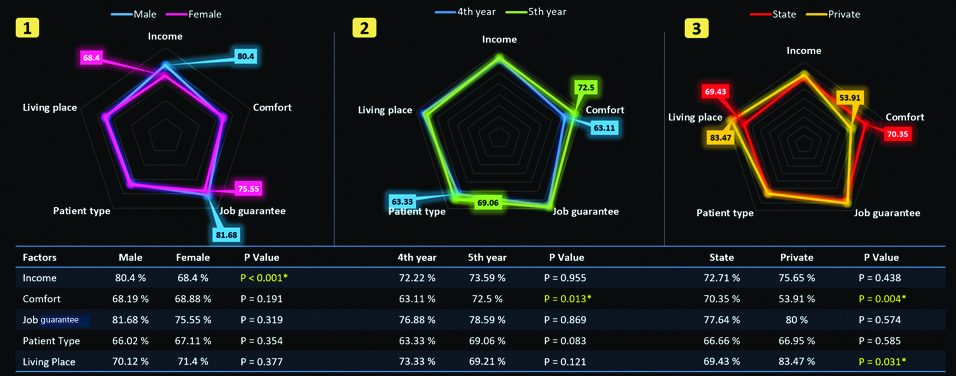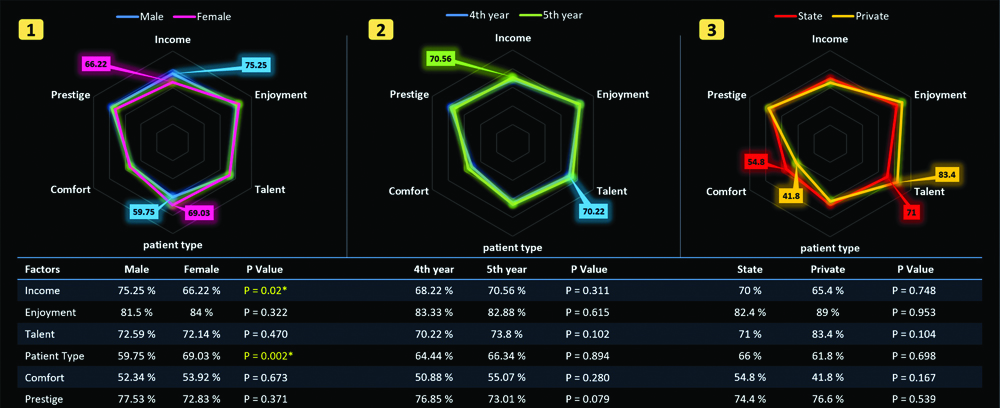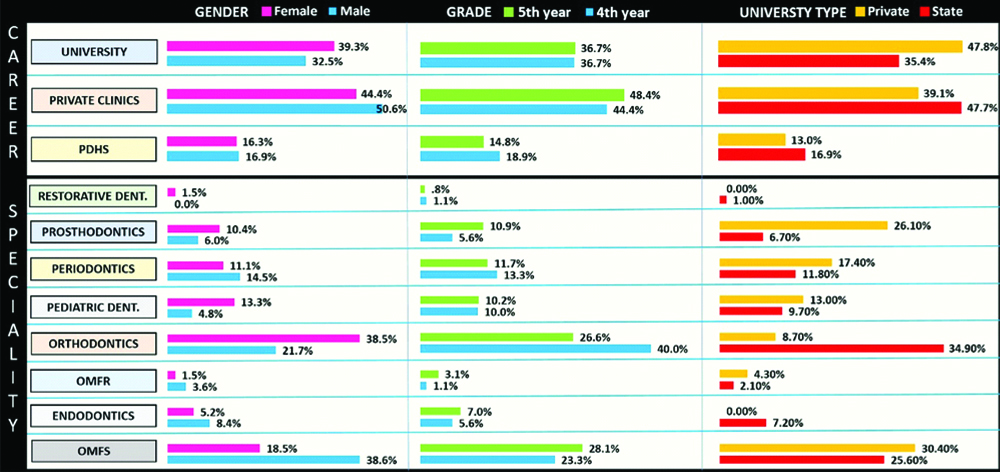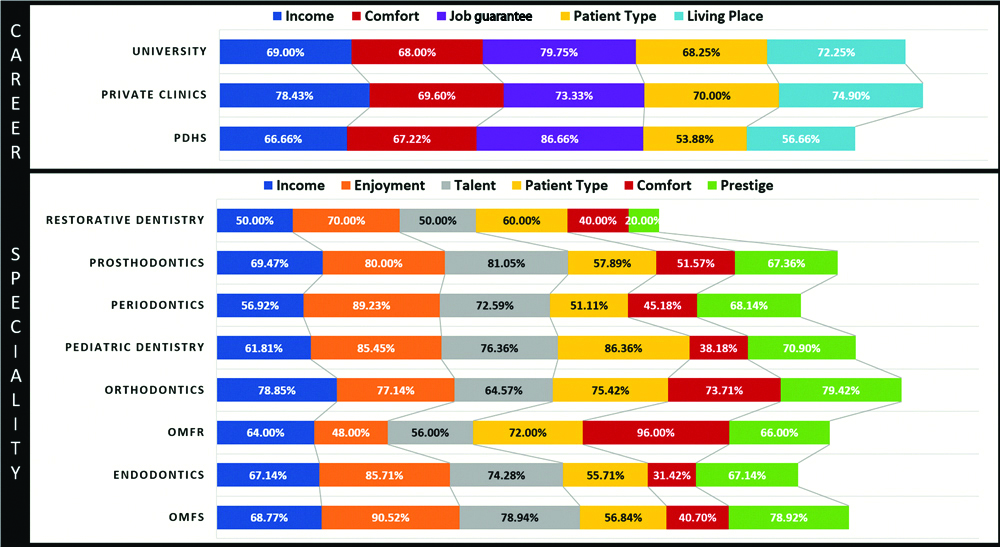Dentistry education in Turkey began with the establishment of the first dentistry school in 1933 [1]. Many schools have been established until today, especially in the last decade, and the number of dentistry schools in Turkey has reached approximately 86 [2]. Increasing the number of schools has led to an increase in the number of dentists who graduated. While 953 dentists were employed in 1951, this number reached 26674 in 2016, while the number of patients per dentist decreased from 22104 to 2992 [3].
After graduation, the workplaces preferred by dentistry students are usually Public Dental Health Services (PDHS), private clinics or universities where they can specialise in a field. According to the data of 2016, 936 PDHS (9055 dental units) and 1802 private clinics (7292 dental units) were available in Turkey. Despite this increase in the number of dentists in recent years, Turkey still ranks 20th in the world in the number of patients per dentist [4]. In recent years, to meet these demands for dental health services, much more dentistry students have settled at universities via educational programmes. As a result of these efforts, 2128 dentistry students graduated in 2016, including 855 male and 1273 female students [5].
Interest in specialising in dentistry is increasing day by day in Turkey. Due to the increase in the number of dentists that have graduated in recent years, there is a growing tendency to specialise in certain fields to keep up with the market conditions. Since increased demands for speciality education require fair placement of students in a speciality field, determining speciality students through examination was agreed upon in 2011 by the government [6]. A total of 262 speciality students graduated in a year according to the data of 2016. Currently, 1466 students are continuing their speciality education in various dentistry schools. The vast majority of these students are receiving speciality training in Oral and Maxillofacial Surgery (OMFS). In the field of Oral and Maxillofacial Radiology (OMFR), there are fewer speciality students than those in other departments [5].
In Turkey, it is needed to assess the impact of changing educational strategies on dentistry students in recent years [7]. The purpose of this study was to analyse the factors that affect dentistry student’s career and speciality preferences in Turkey.
Materials and Methods
An internet survey was conducted from April 2018 to June 2018. Ethical approval was provided by the Ethics Committee at Sutcu Imam University in Turkey (2018-144). The participants provided informed consent. The sample size was calculated using the Raosoft web survey software (http://www.raosoft.com/samplesize.html). With a 95% confidence interval, 5% alpha error, 9790 population size (according to YOK statistical data in Turkey), 370 participants were required [5]. The link which directed people to a web-based questionnaire page (Google forms) was sent to an internet platform which included dentistry students from each dentistry school in Turkey. Only 4th and 5th year Turkish dentistry students participated in the questionnaire.
The survey had an adequate reliability with a Cronbach’s alpha coefficient of 0.796. Questionnaire was prepared based on previous study survey [8-10]. At first, the demographic characteristics of the students were requested in the questionnaire. In the second part, the fields they wanted to work in after they complete their education were asked. Later, the participants were asked how much the factors of income (1); comfort (2); job guarantee (3); patient type (4); and living place (5) affected their career decisions (on a scale of 0 to 5). In the third phase, the field that they would like to specialise in was also asked. Later, the participants were asked how much the factors of income (1); comfort (2); enjoyment (3); talent (4); patient type (5); and prestige (6) affected their speciality decisions (on a scale of 0 to 5) [Table/Fig-1].
Questionnaire which was used for the study.
| 1. What is your career preference after graduation?a) University (Academic or speciality)b) Private Clinicsc) Public Dental Health Services |
| 2. How effective is the income factor on your career choice? (0=ineffective, 5=most effective) |
| 3. How effective is the comfort factor on your career choice? (0=ineffective, 5=most effective) |
| 4. How effective is the job guarantee factor on your career choice? (0=ineffective, 5=most effective) |
| 5. How effective is the patient type factor on your career choice? (0=ineffective, 5=most effective) |
| 6. How effective is the living place factor on your career choice? (0=ineffective, 5=most effective) |
| 7. Which department do you want to specialise in?a) Oral and maxillofacial radiologyb) Restorative Dentistryc) Endodonticsd) Oral and maxillofacial surgerye) Periodonticsd) Paediatric Dentistrye) Prosthodonticsf) Orthodontics |
| 8. How effective is the income factor on your speciality choice? (0=ineffective, 5=most effective) |
| 9. How effective is the enjoyment factor on your speciality choice? (0=ineffective, 5= most effective) |
| 10. How effective is the talent factor on your speciality choice? (0=ineffective, 5=most effective) |
| 11. How effective is the patient type factor on your speciality choice? (0=ineffective, 5= most effective) |
| 12. How effective is the comfort factor on your speciality choice? (0=ineffective, 5=most effective) |
| 13. How effective is the prestige factor on your speciality choice? (0=ineffective, 5=most effective) |
Statistical Analysis
Data analysis was performed by using the Statistical Package for the Social Sciences version 23.0 (SPSS Inc., Chicago, ll., USA). The factors that affected the participants’ decisions were examined using binary logistic regression analysis with descriptive statistics. The Cronbach’s alpha internal consistency coefficient was determined to verify the reliability of the survey. The probability level for statistical significance was set at p=0.05.
Results
A total of 436 Turkish dentistry students participated in the survey. 61.9% of the participants were female, and 58.7% were 5th year students. Additionally, 89.4% of the students who participated in the survey were educated at state universities. The mean age of the participants was 23.12 [Table/Fig-2].
Distribution of Dentistry Students (n=436) according to gender, year of study and university type.
| Demographic features | Factors | n | % |
|---|
| Gender | Male | 166 | 38.1 |
| Female | 270 | 61.9 |
| Year | 4th | 180 | 41.3 |
| 5th | 256 | 58.7 |
| University Type | State | 390 | 89.4 |
| Private | 46 | 10.6 |
The income factor was significantly more effective for the male participants than the female participants in terms of their career preferences (p<0.001). Gender differences did not have a significant effect on the other factors that were effective on career choices (p>0.05). While the comfort factor was more significantly effective on career choices for the 5th-year students (p=0.013), other factors did not make a significant difference (p>0.05). While the comfort factor was more significantly effective on the career choices of the students who were studying at state universities (p=0.004), the factor of place of living was more significantly effective for students who were studying at private universities (p=0.031). There was no significant difference based on the other factors (p>0.05) [Table/Fig-3].
Comparison of factors that affect career choice according to gender (1); year (2); and university type (3).

While the income factor was more significantly effective on the choice of speciality for the male participants (p=0.02), the patient type factor was much more essential for the female participants (p=0.002). Gender differences did not have a significant effect on the other factors that were effective on their speciality choices (p>0.05). Different years of study and types of universities did not significantly affect the speciality preferences of the dentistry students (p>0.05) [Table/Fig-4].
Comparison of factors that affect speciality choice according to gender (1); year (2); and university type (3).

Private clinics were the most frequently preferred career choice among the participants. While the male participants (50.6%) and those who were educated at state universities (47.7%) preferred private clinics more, the female participants (39.3%) and those who were educated at private universities (47.8%) preferred the university more as a career. The 4th and 5th year students preferred the university almost equally (36.7%). PDHS was the least preferred career choice for both genders, years of study and types of universities [Table/Fig-5].
Descriptive statistics of career and speciality selections according to demographic characteristics.

The male (38.6%), 5th year (28.1%) and state university (25.60%) students preferred OMFS as a speciality field much more. However, the female (38.5%), 4th year (40%) and state university (34.9%) students preferred orthodontics much more. The least preferred option was restorative dentistry for both genders, years of study and types of universities.
In terms of income (78.43%), comfort (69.6%), patient type (70%) and living place (74.9%), private clinics were the most frequently preferred option. PDHS was the most frequently preferred option in terms of job guarantee (86.66%). In terms of income (66.66%), comfort (67.22%), patient type (53.88%) and place of living (56.66%), PDHS was the least preferred option [Table/Fig-6].
Descriptive statistics of career and speciality selections according to the factors.

In terms of the factors of income (78.85%) and prestige (79.42%), orthodontics was the most preferred option. In terms of enjoyment, talent, patient type and comfort, OMFS (90.52%), prosthodontics (81.05%), paediatric dentistry (86.36%) and OMFR (96%) were the most preferred options, respectively. In terms of the factors of income (50%), talent (50%) and prestige (20%), restorative dentistry was the least preferred. In terms of the enjoyment and comfort factors, OMFR (48%) and endodontics (31.42%) were the least preferred, respectively.
Discussion
The number of dentists has increased in recent years as a consequence of the risen number of dentistry schools established in Turkey, so this situation has had a profound effect on students in terms of choosing their career plans. Although a pilot study that was conducted in 2011 at a private school measured the impact of factors that affected career and speciality selection in Turkey, the dynamic situations in recent years have escalated the demand for a supplementary study [7]. Surprisingly, there has been more participation from women in the questionnaire. The reason may be that the number of women who study dentistry is much higher than that of men in Turkey according to YOK (Council of higher education) data [5]. Furthermore, dentistry students perform their clinical practice in their last 2 years, so, the present authors deliberately included 4th and 5th year students for a realistic evaluation [11].
With the growing number of dentists in recent years, the career plans of Turkish dentistry students vary in comparison to the past. Financial grounds are at the top of the reasons for selection of the profession of dentistry in Turkey [7]. Newly graduated students have to choose between joining the workforce immediately or continuing their education as specialists [12]. However, the decline in the economic share per dentist triggers dental students to choose more specialised fields [7]. Similarly, in many countries, there is a great deal of interest in specialisation training [Table/Fig-7] [7-10,12-20].
Summary of the survey studies related to career and speciality [7-10,12-20].
| Studies | Year | Country | Career | Speciality |
|---|
| MP | LP | MP | LP |
|---|
| Weaver RG et al., [13] | 2005 | U.S.A. | Private Practice | Academic | Implant dentistry, Orthodontics | Basic Medical-Dental, Restorative Dentistry |
|---|
| Walton, JN et al. [14] | 2006 | Canada | Private practice | Military dentistry | - | - |
| Scarbecz, M et al., [15] | 2007 | USA | - | - | Orthodontics | Prosthodontics |
| Karibe H et al., [16] | 2009 | Japan-Sweden | Speciality | General Practitioner | OMFS, Orthodontics | Pedodontics, Prosthodontist, |
| Zarchy M et al., [10] | 2011 | USA | Speciality | Military | Orthodontics | OMFR |
| Aggarwal A et al., [17] | 2012 | India | Speciality | Community Dentistry | OMFS | Periodontics |
| Dhima M et al., [9] | 2012 | USA | Speciality | Dental public health, Academic | OMFS, Orthodontics | OMFR, oral pathology |
| Tanalp J et al., [7] | 2012 | Turkey | Speciality | - | Orthodontics, OMFS | - |
| Rashid H et al., [18] | 2013 | United Arab Emirates | - | - | Orthodontics | Oral Pathology |
| Yan X et al., [19] | 2014 | China-Japan | Japan: General dentist China: Specialist | Educator | Japan: OMFS, Prosthodontist China: Prosthodontist | Endodontics |
| Shin JH et al., [8] | 2015 | USA | Speciality | Dental public health | Orthodontics | Endodontics, Prosthodontics |
| Halawany HS et al., [12] | 2017 | Saudi Arabia | Civilian dentist in public sector | Business outside dental field | Restorative and aesthetic dentistry | Oral pathology |
| Giummarra A et al., [20] | 2018 | Australia | General dentist | Speciality | Orthodontics | OMFR |
| Present Study | 2019 | Turkey | Private clinics, Speciality | PDHS | Orthodontics, OMFS | Restorative Dentistry, OMFR |
MP: Most preferred; LP: Least preferred
The government has also encouraged dentistry students to be specialised since 2011 by organising a speciality examination [21]. However, students who receive a scholarship during their education process can compromise the speciality examination to pay their debts [9]. It was stated that the debt of graduates are one of the major factors that affect the preference of specialities in the USA and Canada [13,22].
In parallel to the studies that have been carried out in different countries, it was observed that men attach more weight to income after graduation [7,15,23-25]. It was stated that “helping people” is more valuable for women [15,24]. Additionally, another likely reason for this may be the fact that, in eastern cultures, the home budget belongs mostly to men. In the same direction as different studies, men prefer to work at private clinics much more instead of government institutions in Turkey [9,12,23,26]. A previous study reported that PDHS are especially preferred because of the job guarantee and fixed retirement income in Turkey, like in Saudi Arabia [27]. Previously, studies stated that job guarantee is more important for students who are in their earlier class years in comparison to those in their later class years [11,24]. These data may explain the finding in the present study that the students in their 4th year of study preferred PDHS more. In the present study conducted at a private university in 2011, 25.3% of students in Turkey said they wanted to continue academic life after graduation [7]. In our study, this ratio was about 47.8%, especially for private universities. There were fewer dentistry schools in the year 2011, and the speciality examination had not begun yet. These factors may have increased the attractiveness of specialisation and an academic career. Furthermore, Swedish, Thai and Japanese students also mentioned that they desired speciality training by 37%, 39% and 17%, respectively [16,22].
It is noticed that the most significant sources of motivation for working at private clinics were high income and the opportunity of living in the cities they wanted. It is also observed that treating patients with much higher socioeconomic levels and being more comfortable increase the attractiveness of private clinics. In this study, the male participants preferred private dentistry much more, yet in a study conducted in the USA, the result seemed to be the opposite [28].
In terms of income and prestige, Turkish dentists, especially women, preferred the speciality of orthodontics much more. Although prestige is an essential factor for Turkish, Saudi and Iranian students, it does not seem to be a much prominent factor for British, Danish, Australian and Canadian students [23,24,29-31]. The difference between the eastern and western cultures, as well as socio-economic variabilities, may be a possible cause of this condition. However, men are more interested in OMFS. According to the results of the present study, enjoying surgical procedures seemed to be an important factor in the preference of OMFS. Furthermore, Dhima M et al., noted that enjoyment was the most important factor in comparison to all other factors [9]. These results corresponded with studies which were carried out in Turkey and different countries [7,12,27,32,33]. In particular, Turkish female dentistry students are more likely to opt for orthodontics and paediatric dentistry. Additionally, it is seen that “patient type” is significantly more effective on the preferences of women. The lower mean age of patients in orthodontics and paediatric dentistry may be a possible reason for this. A study conducted in Nigeria stated that the major motivation of those who prefer paediatric dentistry is to improve the health of children. However, unlike the case in the present study, Nigerian men demanded paediatric dentistry more [34]. However, in the USA, Saudi Arabia and the United Kingdom, females are more prone to prefer paediatric dentistry in parallel with the present study [9,27,35].
Procedures at private university hospitals are chargeable; therefore the socioeconomic levels of the patients are higher than the average. Additionally, the number of patients that are treated is lower than that of state university hospitals. Hence, it is possible that those who studied at state universities preferred comfort more as they had seen the difficulties of professional life. The same comparison may be made between the 4th and 5th year students. With a similar approach, students of state universities may have a higher level of self-confidence because they treat more patients, so, they may prefer private clinics much more. Furthermore, private universities are usually located in major cities such as Istanbul, Ankara and Izmir. The cities with high socioeconomic status might be preferred much more by students who receive their education in equivalent cities.
Although OMFR is one of the least preferred fields of speciality, it seems to be the first choice for those who care about the comfort factor. On the other hand, endodontics is seen as an exhausting and difficult speciality field. Yet, possibly due to other factors, endodontics was preferred more than OMFR. When one is concerned with restorative dentistry, Turkish dentistry students considered it as non-prestigious. While, surprisingly, it is the most valued speciality field among dentistry students in a study conducted in Saudi Arabia [12,33], in a study that was carried out in the USA, there were results in parallel with the present study [9]. In a USA survey, 54% of graduates stated they felt ready for preventive and restorative dentistry, but not for prosthodontics, orthodontics and OMFS [36]. According to this, it may be concluded that students have concerns about the fields in which they perceive themselves to be ineffective. This impulse may explain the lack of interest in restorative dentistry and OMFR, as well as clarifying why students at private universities choose prosthodontics more.
Limitation
The questionnaire was distributed through an internet platform, so only students who were on this platform participated in the study. Additionally, in this platform, although there were dentistry students from all universities in Turkey, the distribution of the students based on universities might not have been uniform. Further studies should be carried out to eliminate these limitations.
Conclusion
Based on the results of this study, it may be concluded that demographic characteristics such as gender, grade and type of universities may change the career and speciality decisions of Turkish dentistry students. Orthodontics is the favourite speciality field of Turkish students. Also, OMFS is the second most favoured speciality field. However, minimal interest is given to restorative dentistry. Although income and prestige are the main factors in these decisions, it is clear that there are various factors that motivate the preference of each speciality field.
MP: Most preferred; LP: Least preferred